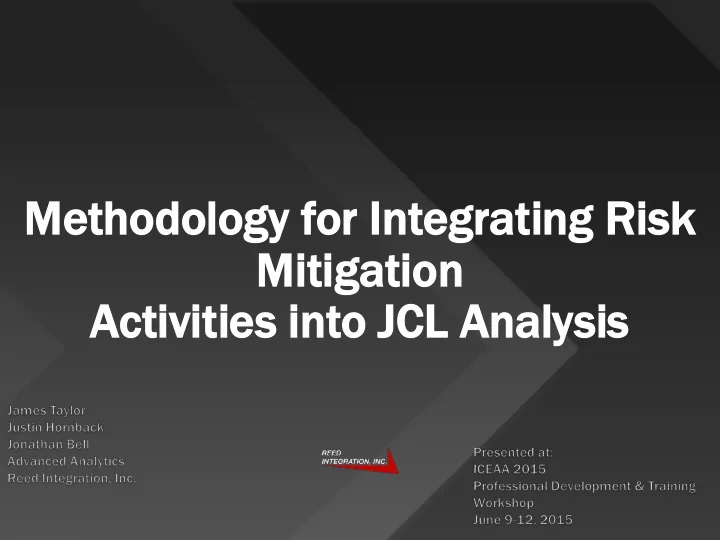

Metho Methodology dology for In r Integrating grating Ri Risk k Mi Mitiga igation tion Act ctiv ivitie ities s in into o JC JCL An L Analy alysis sis
Overview Current Joint Confidence Level (JCL), Cost and Schedule Analysis results reflect risk adjusted scenarios based on current risk impact assessments, do not take into account cost and schedule required by mitigation efforts Risks captured within JCL models should represent a project’s current risk posture that takes into account planned mitigation and efforts completed to date Capturing post mitigated risk (residual risk) requires a logical and traceable mitigation plan to not only be outlined, but captured and managed within a project baseline 2
Why does this matter? Example: Per NASA’s Program Requirements (NPR) 8000.4A, Continuous Risk Management (CRM) states that all risk activities should be consistent with all internal programmatic controls Meaning that tracking cost and schedule progression of risk mitigation efforts should align with the processes/procedures for managing a project Simply outlining a mitigation plan does not equate to successful mitigation of risk This theory, which is not new, applies to both Private/Public sectors and considered best practice Managing risk mitigation activities is one key aspect of managing project cost and schedule growth 3
How can risk mitigation drive cost/schedule growth? Risk mitigation activities are often driving factors of a project success Risk mitigation can be categorized as Problem or Proactive based Problem based mitigation focuses on mitigating an known problem/risk This could be categorized as an issue that has not come to fruition Proactive based mitigation focuses on mitigating a potential known risk with unknown impacts 4
Capturing Risk Mitigation within a Probabilistic Risk Analysis To adequately assess risk mitigation costs, resources and tasks should be captured accordingly within budget and IMS Tracking mitigation efforts should not vary from standard procedures for managing current planned work It is beneficial to create sub-WBS lines that captures mitigation efforts within specific WBS elements Range estimates for cost and duration should be established for mitigation efforts Uncertainty surrounds how long it will take to fully mitigate a risk/problem 5
Uncertainty of Risk Mitigation Risk mitigation efforts do not completely negate uncertainty surrounding planned work as uncertainty relates to unknown- unknowns Mitigation efforts may reduce uncertainty around planned work within a WBS element, but does not eliminate unknown- unknowns Mitigation efforts are not exempt from uncertainty, often times mitigation of risk runs longer and costs more than originally planned Mitigation efforts estimates are not 100% definite Mitigation efforts are directed at known and unknown events with somewhat unknown impact Mitigation uncertainty is aimed to capture unknown events that have an unknown impact 6
Capturing and Comparing Residual Risk Not all risks can or are fully mitigated, in many cases the potential for a risk impacting a project exists after completing mitigation efforts In most cases, mitigation efforts are aimed at reducing likelihood of occurrence which is what should be captured in post mitigated (residual risk) values Capturing post mitigated risk values within a probabilistic risk analysis can also provide project stakeholders more insight of the path to success, but only if captured correctly Comparing pre and post mitigation analysis provides insight to project’s stakeholders into how much risk can be burned down and what it will take to get there 7
Assessing Mitigation Cost Effectiveness Capturing the potential risk burn down of Pre and Post mitigated risk events helps assess efficiency of resource allocation Supports project stakeholders in making mitigation decisions when facing budget constraints Success ssful l mitigatio ation effor orts ts redu educe $ 198.8 M pot oten entia ial l cost ost impa mpacts ts cos ost t by $178.7M .7M. . With a $20.1M M growth wth incurred ed from m resid sidual al risk sk and d mitigat igatio ion effor orts. s. $ 20.1 M Pre-mitigat mitigated ed risk impa mpact t cost st by $198.8M .8M 8
Assessing Mitigation Schedule Effectiveness Schedule slips from risk impacts, mitigation efforts and/or uncertainty will directly affect overall project cost growth Cost growth does not always directly translate to schedule growth, but schedule growth normally translates to cost growth Supports project stakeholders in making mitigation decisions when facing schedule constraints 9 Months 6 Months 9
Conclusion To adequately assess mitigation effectiveness, Project’s need to track costs and activities associated in risk mitigation efforts Ex. Incorporate into re-baseline or track within risk management Simply showing a mitigation plan has been developed does not translate to successful mitigation efforts Cost and schedule overruns pertaining to mitigation efforts correlates to an exponential overall impact on a project cost and schedule growth Assessing Pre and Post mitigation results helps project in deciding effective and efficient utilization of resource allocation, as well as planning for potential residual risk Adequately incorporating risk mitigation efforts into a risk analysis should provide a more “realistic” snapshot with regard to what the path to success really looks like Questions? 10
Contact James Taylor Justin Hornback jtaylor@reedintegration.com jhornback@reedintegration.com (256) 701-3650 757-435-0050 Jonathan Bell jbell@reedintegration.com 757-541-8039 11
Recommend
More recommend